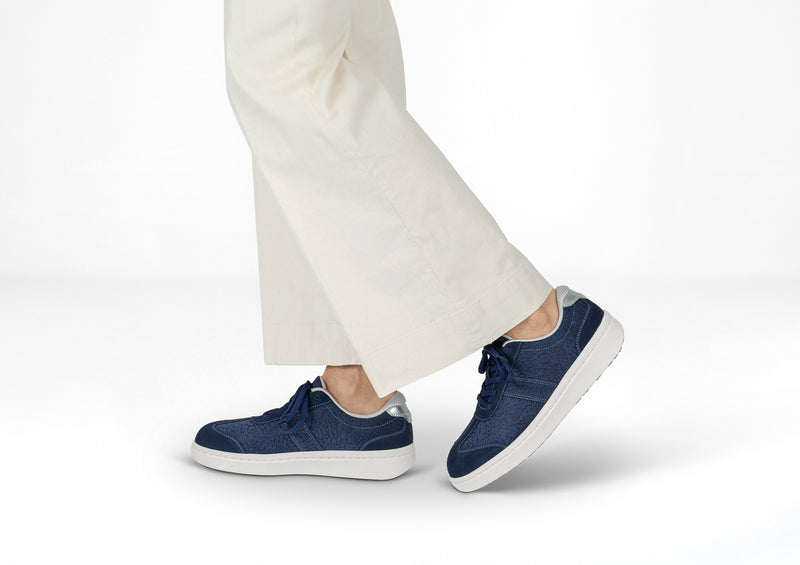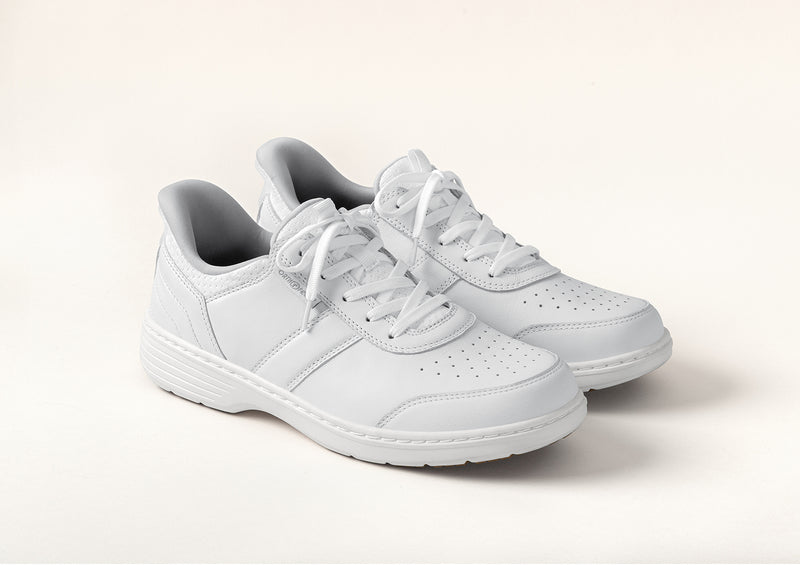Tarsal Tunnel Syndrome - Finding the Right Shoes
By Steven Gershman DPM / January 26, 2023 Blog HomeShoes for tarsal tunnel syndrome should have good arch support, cushioning, sturdy heel counter, extra depth and firm midsole and outer sole. Before I explain why, let’s jump straight into my list of the best shoes for tarsal tunnel.
If you want to learn about the syndrome and how to treat and prevent it, simply scroll down or continue reading.
The 6 Best Shoes for tarsal tunnel syndrome
Sneakers: Women’s Coral | Men’s Edgewater

These stylish and extremely comfortable sneakers are designed with extra depth and anatomical orthotic insoles with superior arch support, which help minimize over pronation, alleviate tarsal tunnel pain and align the foot with the rest of the body.
The outer sole is firm, yet flexible enough at the toes to allow natural foot movement and reduce motion while walking.
Another feature that makes these sneakers great for tarsal tunnel is the stretchable upper materials that conform to your foot shape and size, providing a customized fit.
Edgewater is available in black, gray and blue, while the blue and gray styles are constructed with a rubber outsole that provides advanced grip on any surface.
Coral is available in black, gray, turquoise, silver, lavender, blue, white, wool gray and black with black sole.
Boots: Women’s Florence | Men’s Ryder

These boots feature orthotic insoles that make them extremely comfortable and provide unparalleled support.
The lightweight, yet firm and cushioning soles alleviate stress on the joints and facilitate proper foot motion, helping minimize tarsal tunnel pain and deterioration.
On the inside, the anatomical orthotic insoles support the arches and feet at all times and on the outside, the non-binding uppers are firm enough to prevent the feet from collapsing when you walk.
Both boots are also designed with features that make it super easy to slip in and out of them.
The Florence boots open up widely, allowing the tongue to fall forward, thanks to two hook and loop straps across the instep, while the Ryder boots have two zippers at the heel to offer a wide opening, allowing you to effortlessly insert your foot.
The Florence shoes are available in black and camel, and there’s two waterproof versions in black and brown. Ryder is available in black and brown.
Walking: Women’s Delta Black | Men’s Hunter Black

Walking in these shoes feels like you’re stepping on a soft pillow while being fully supported.
With a firm and cushioned heel counter, these hiking shoes wrap around the heel to keep it from rocking from side to side and putting pressure on the tarsal tunnel.
Both boots are designed with durable, waterproof leather and are sealed at the seams, so that no liquids seep through, while the rubber outsole with its unique grooves channels liquids away.
Here, too, the premium orthotic insoles offer excellent arch support to help prevent over pronation and the mild rocker sole design allows you to walk with less effort.
Both boots are also available in brown, but these styles are not waterproof.
What is tarsal tunnel syndrome?
While many people have never heard of tarsal tunnel syndrome, most have heard of or actually have been diagnosed with carpal tunnel syndrome.
Carpal tunnel syndrome affects the arms, wrists, and hands. It is basically a nerve entrapment causing pain, electrical like sensations, numbness and weakness.
Tarsal tunnel syndrome (sometimes referred to as carpal tunnel syndrome in feet) is a similar problem that affects the feet, ankles and sometimes the lower leg. The word carpal is a Latin term meaning hand, while tarsal is a Latin term for feet.
The tarsal tunnel is a canal on the inside or medial side of the foot, just below and aside the inner ankle, specifically where the medial malleolus is located.
Inside the canal is a large nerve, almost as thick as a pencil, called the posterior tibial nerve, and its three main branches. Also in the canal are blood vessels and three tendons going from the leg to the foot. In effect, they are bundled together in the canal under a roof of ligament.
What are the causes of tarsal tunnel syndrome and its symptoms?
True tarsal tunnel syndrome occurs when the nerve is entrapped in the canal by several possible factors, including swelling from inflammation, thickening of the tendons adjacent to the nerve due to overuse of the tendons, or scar tissue on the nerve coating as a result of chronic irritation.
Any of these can produce pressure on the nerve in the enclosed canal, which then causes the symptoms.
Symptoms of tarsal tunnel syndrome can include:
- Pain directly over the canal
- Shooting electrical sensations into the bottom of the foot as the nerve innervates the bottom of the foot
- Pain or electrical sensations going back up the lower leg on the inside of the leg
- Numbness or complete lack of feeling on the bottom of the foot in severe cases
In general, the most common cause of this syndrome is hypermobility or simply put, too much motion in the foot.
Hypermobility causes increased torque forces on the leg, ankle and foot, stressing the ligaments that hold the bones together. By itself, hypermobility causes irritation to the tissue and can lead to inflammation, swelling and scar tissue, which are potential factors in tarsal tunnel syndrome.
However, it doesn’t end there.
As the body senses hypermobility, it tries to compensate to protect itself. The three tendons in the tarsal tunnel have several functions, but a major one is stabilization of the foot. With hypermobile feet, the tendons overwork.
WOLFS law basically states that as a body part is stressed (such as a muscle that enlarges when weightlifting is performed) it will grow larger in proportion to that stress. The tendons become thicker, taking up more room in the tarsal tunnel and can become inflamed from the overuse and swell.
This can cause tendonitis, which adds to the pain and scarring. Either way, the nerve is entrapped in the limited space of the canal.
There can be other causes of nerve entrapment, such as space occupying lesions, tumors or bone spurs, deformities of the canal, nerves or tendons, metabolic syndromes that affect the nerve directly, vein problems causing swelling, or injuries directly impacting the canal.
However, the most common cause in my practice is hypermobility, especially with flat feet or post pregnancy, which weakens the ligaments with soft, worn out shoes.
Too much pronation, which in general terms means rolling-in of the foot with associated arch drop, also causes hypermobility.
Do orthotics help tarsal tunnel syndrome?
Treatment of tarsal tunnel syndrome begins with diagnosing the underlying cause. Once you have been diagnosed with the possible cause, there are a few simple steps you can take to treat your painful symptoms and yes, orthotics are definitely on this list.
Orthotics
Wearing orthotics is even more effective than just wearing the best shoes for tarsal tunnel syndrome.
The shoes and orthotics work as a synergistic pair and both need to be of superior quality and function for each patient.
Good orthotics should have a prominent arch to support the foot and prevent it from over pronating, as well as shock absorption features to cushion and help relieve pain.
Shoes
With the most common cause of hypermobility, the first step is to wear shoes that are appropriate for tarsal tunnel syndrome. That begins with the age of the shoe.
As shoes age, the leather stretches and warps as does the midsole material that acts as a stabilizer. This leads to the outsole irregularly wearing out. All these factors cause increased motion, which is counterproductive to tarsal tunnel treatment.
In general, shoes that are worn regularly should be replaced at least once per year and more often if under heavy use. In many cases of foot pain, new and more appropriate shoes have been the only treatment to solve the issue.
What are the best shoes for tarsal tunnel syndrome?
New or nearly new shoes of the correct size, both in length and width, are advisable. If the shoes don't fit correctly, they can allow either too much motion or warp, which leads to damaging abnormal motion.
The best shoes for tarsal tunnel syndrome will have most or all the features below.
- A good tarsal tunnel shoe will be a motion control shoe with extra depth.
Motion control shoes have a sturdy firm heel counter, which is the back of the shoe that wraps around the heel. This area of the shoe is critical in keeping the heel from wobbling, which torques on the tarsal tunnel.
In addition, the shoe needs a solid and firm midsole and outer sole so it doesn't bend easily in the middle, but allows some bend near the toes.
Shoes with a sturdier midsole material are beneficial on the inside or tarsal tunnel side from the heel to the midfoot. This rigid material resists the foot from collapsing when it pronates or rolls in.
- A low heel close to the ground is generally useful in reducing motion.
- Extra depth shoes are important as they allow better control of the foot motion, because the deeper the shoe the more material resists the motion. In addition, extra depth shoes can accommodate custom orthotics or specialty insoles, which are a major component in treatment.
- Good arch support built into the shoes aligns the feet and helps keep them in the neutral position, minimizing pronation. The correct arch height will also help transfer pressure off your tarsal tunnel and relieve pain.
- Shoes with removable insoles to accommodate custom orthotics, or braces (AFOs).
In shoe brace
In severe cases of tarsal tunnel syndrome, an in-shoe brace, such as a so-called gauntlet AFO, is used. This delivers maximum control of the motion problem.
This type of device usually requires a special shoe, preferably one that is stretchable, so that it can accommodate the brace. You will need shoes that are designed with a deep and wide shape, including a wide toe box, to ensure a comfortable fit for the brace.
In addition, the built-in insole should be removable to free up even more space and accommodate custom orthotics.
Non-surgical treatment
There are several treatment options for non-surgical care for tarsal tunnel syndrome.
After exhausting motion control options such as shoes and orthotics, medication, injections, cold laser, and sometimes complete immobilization in a cast or boot for several weeks, may be required.
Physical therapy modalities can be useful, but in general I haven't seen much improvement from tarsal tunnel exercises or tarsal tunnel stretches, as they can further irritate the tissue.
Bottom line, the best treatment for tarsal tunnel syndrome is prevention.
It all starts with proper, well made and non worn out shoes. So many foot problems could be prevented by following this simple rule.


